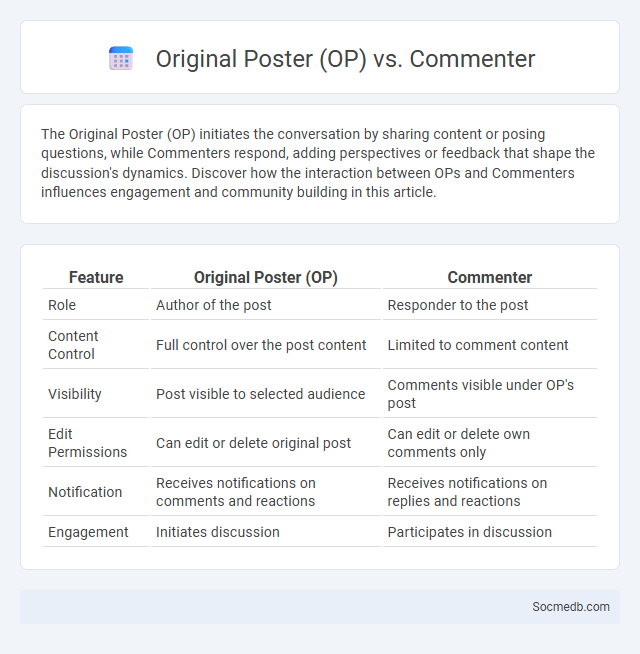
Photo illustration: Original Poster (OP) vs Commenter
The Original Poster (OP) initiates the conversation by sharing content or posing questions, while Commenters respond, adding perspectives or feedback that shape the discussion's dynamics. Discover how the interaction between OPs and Commenters influences engagement and community building in this article.
Table of Comparison
| Feature | Original Poster (OP) | Commenter |
|---|---|---|
| Role | Author of the post | Responder to the post |
| Content Control | Full control over the post content | Limited to comment content |
| Visibility | Post visible to selected audience | Comments visible under OP's post |
| Edit Permissions | Can edit or delete original post | Can edit or delete own comments only |
| Notification | Receives notifications on comments and reactions | Receives notifications on replies and reactions |
| Engagement | Initiates discussion | Participates in discussion |
Introduction to Original Poster (OP), Commenter, and Comment Thread
The Original Poster (OP) initiates a social media discussion by sharing content that sparks engagement from the community. Commenters respond directly to the OP or to each other, creating dynamic comment threads that facilitate detailed conversations and diverse perspectives. Understanding the roles of the OP, commenters, and the structure of comment threads enhances your ability to navigate and participate effectively in social media interactions.
Defining the Roles: OP vs Commenter
In social media interactions, the Original Poster (OP) shapes the conversation by setting the topic, tone, and context through their initial post. Commenters contribute by expanding the discussion, offering diverse perspectives, and providing feedback that can enhance or challenge the original message. Understanding these distinct roles helps you engage more effectively, ensuring your responses add value and foster meaningful dialogue.
The Structure of a Comment Thread
A comment thread on social media platforms is structured hierarchically, starting with an original post followed by user comments arranged chronologically. Each comment can generate nested replies, creating multi-level discussions that enhance user engagement and community interaction. Platforms like Facebook and Reddit utilize this threaded design to facilitate organized conversations, improve content discoverability, and promote dynamic user interaction.
How OP Initiates Online Discussions
OP initiates online discussions by crafting clear, engaging posts that invite responses and create a sense of community. They often use open-ended questions and relevant hashtags to increase visibility and encourage diverse perspectives. Your ability to spark meaningful conversations hinges on the balance between informative content and interactive prompts.
The Impact of Commenters on Thread Dynamics
Commenters play a crucial role in shaping thread dynamics by influencing conversation flow and engagement levels on social media platforms. Your participation can either amplify diverse viewpoints or contribute to echo chambers, affecting community sentiment and the visibility of posts. Understanding how comment patterns and sentiment affect algorithmic promotion is essential for optimizing user interaction and fostering meaningful discussions.
Interaction Patterns within Comment Threads
Interaction patterns within social media comment threads reveal how users engage through replies, likes, and mentions, creating dynamic conversations that enhance content visibility. Understanding these patterns helps optimize your social media strategy by identifying influential commenters and trending discussion topics. Leveraging these insights increases user engagement and fosters a more active online community.
Moderation and Etiquette for OPs and Commenters
Effective social media moderation ensures respectful interactions by promptly addressing inappropriate content and maintaining community guidelines. OPs can foster positive discussions by clearly setting expectations and modeling polite behavior, while commenters enhance conversations by providing constructive feedback and avoiding inflammatory language. Your active participation in upholding etiquette strengthens trust and encourages meaningful engagement across the platform.
Common Challenges: Miscommunication and Thread Deviation
Social media platforms often face the common challenges of miscommunication and thread deviation, where messages are misunderstood or conversations stray from the original topic. Miscommunication can result from ambiguous language, lack of tone, or cultural differences among users, leading to conflicts or misinformation. Thread deviation disrupts coherent discussions, making it difficult for participants to follow or contribute meaningfully to the conversation.
Best Practices for Constructive Comment Threads
Encouraging respectful, on-topic discussions and moderating to remove harmful content are essential best practices for constructive comment threads on social media platforms. Utilizing clear community guidelines and fostering positive engagement helps maintain a productive environment for diverse viewpoints. Prompt responses and acknowledging differing opinions further enhance meaningful interactions and trust among users.
Conclusion: Enhancing Online Dialogue through OP and Commenter Roles
Enhancing online dialogue relies on the clear identification of OP (Original Poster) and commenter roles, which fosters accountability and encourages respectful exchanges. Your active participation as both OP and commenter can create a more engaging, constructive social media environment by promoting transparency and reducing misunderstandings. Prioritizing role clarity enhances the quality of discussions and strengthens community trust on social platforms.
 socmedb.com
socmedb.com